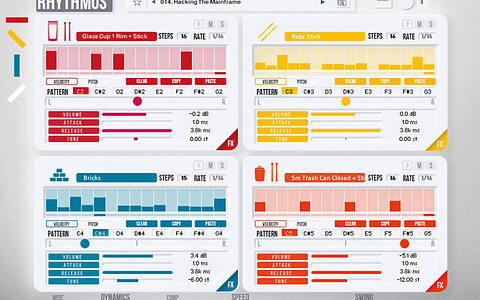
Talkback: Anna Laverty
Now resident in Melbourne, Australia, this former Miloco Studios producer/engineer takes our 9-question challenge.
To find the exact phrase, put the words in quotes or join them together with a plus sign e.g. live+recording or "live recording".
To find, say, all live recording articles that mention Avid, enter: live+recording +avid - and use sidebar filters to narrow down searches further.

Now resident in Melbourne, Australia, this former Miloco Studios producer/engineer takes our 9-question challenge.

Tegeler add convenient plug‑in remote control to one of their best‑selling processors.

Good photography, like a good recording, comes from a mix of experience and pragmatism...


Rating: ***** 5/5 Stars. Rhythmus is built from over 2.5GB of samples taken from a variety of ‘found’ percussion.

If you’re new to recording, it often pays to keep things simple, and when it comes to guitar cabs that means learning how to get the best sound with only one microphone.

Paul White explains the basics of Auto-Tune and demonstrates 7 tips to help you create a variety of alternative textured soundscapes.

The career of LA producer and engineer Mark Linett spans everything from live mixing for Frank Zappa to engineering for Randy Newman and the Red Hot Chili Peppers. We talked to him about his studio, the gear of past and present, and his extensive work remixing and remastering classic Beach Boys records.

Across 17 years and eight albums, Field Music have become one of Britain’s best-loved guitar bands. They’ve also evolved a...

Michelle Moog Koussa, Executive Director of the Bob Moog Foundation, talks to Rob Puricelli about her father's legacy.

UA have long been among the best developers of analogue‑modelling software, so the world is expecting great things of these little boxes. Do they deliver the goods?

EastWest/Quantum Leap unveil their expanded orchestral masterwork and built‑in orchestrator.

Friends and family threw a surprise “British” party for legendary engineer, producer and artist Alan Parsons in celebration of an OBE awarded to him in the Queen’s Birthday Honours in June for services to music and music production.

Visionary synth designer and electronic music composer Peter Zinovieff has died, aged 88.

Paul White's explainer guide to the most important parameters and functions you need to grasp to make the most of MIDI.

NUGEN Audio's surround-sound plug-in collection is on sale until 22nd July.
A term widely used in artifical reverb systems to describe a reverberant space with a specific sonic character. Typically, a chamber reverb is generous and dense, but usually with greater focus and clarity, and less duration, than a Hall reverb. Histortically, a physical reverb chamber was a moderate sized room with tiled surfaces and often glazed pipes stood on end to increase the reverb density, in which one or more loudspeakers reproduced sounds which were picked up by one or more distant microphones.
The noise floor defines the amplitude of the sum of all noise sources and other unwanted signals within a system. This could be the ambient acoustic noise in a room, or the electrical noise in a recording system or other audio equipment. In a high quality audio system the noise floor is typically around -100dBu or better. The total dynamic range capability of a system is normally defined as the difference in amplitude between the noise floor and the highest signal that can be passed without distortion.
Relating to the waveform characteristics of an AC signal such as an audio waveform. It decribes the ratio between the peak amplitude and the RMS level. The 'peakier' or more dynamic the signal, the greater the crest factor. Crest Factor is normally expressed in decibels.
A pure sine wave has a crest factor of 1.414 or 3.01dB, while a triangle wave is 4.77dB and a square wave 0dB.
A 'Dummy Head' is a binaural recording array which intentionally resembles (to a greater or lesser degree) the size and shape (and sometimes also the density) of the average human head, with two microphones placed on opposite sides in the positions of the ear canals. The idea is to capture passing sound waves in the sa,e way as a normal listener would perceive them, with the correct inter-aural time delays and head shadowing effects which are critical to assessing directional cues.